Impermanent Shelter
The impetus for Impermanent Shelter began with research into mid-century, dematerialised practice and its preoccupation with air and atmosphere. Of particular interest was a body of work that preceded this period, the French proto-conceptual artist Yves Klein and his “Air Architecture” project. The project incorporates a series of texts and ancillary works by Klein; a process of research, design and development in collaboration with the German architect Werner Ruhnau; later sketches by the French architect Claude Parent; and even a model for an air-powered rocket devised with the French industrial designer Roger Tallon. The project began in 1958, four years prior to Klein’s untimely death, when he first worked for Ruhnau as a commissioned artist for the architect’s new opera house in Gelsenkirchen, Germany. Separate from the main structure, Klein and Ruhnau devised an “air cafe” where curtains of pneumatic air would protect customers from the elements. Klein patented Ruhnau and his first designs in 1959 for an “air roof”, as well as mechanisms to create fire fountains. Air and fire remain as framing elements for the broader works presented in Impermanent Shelter.
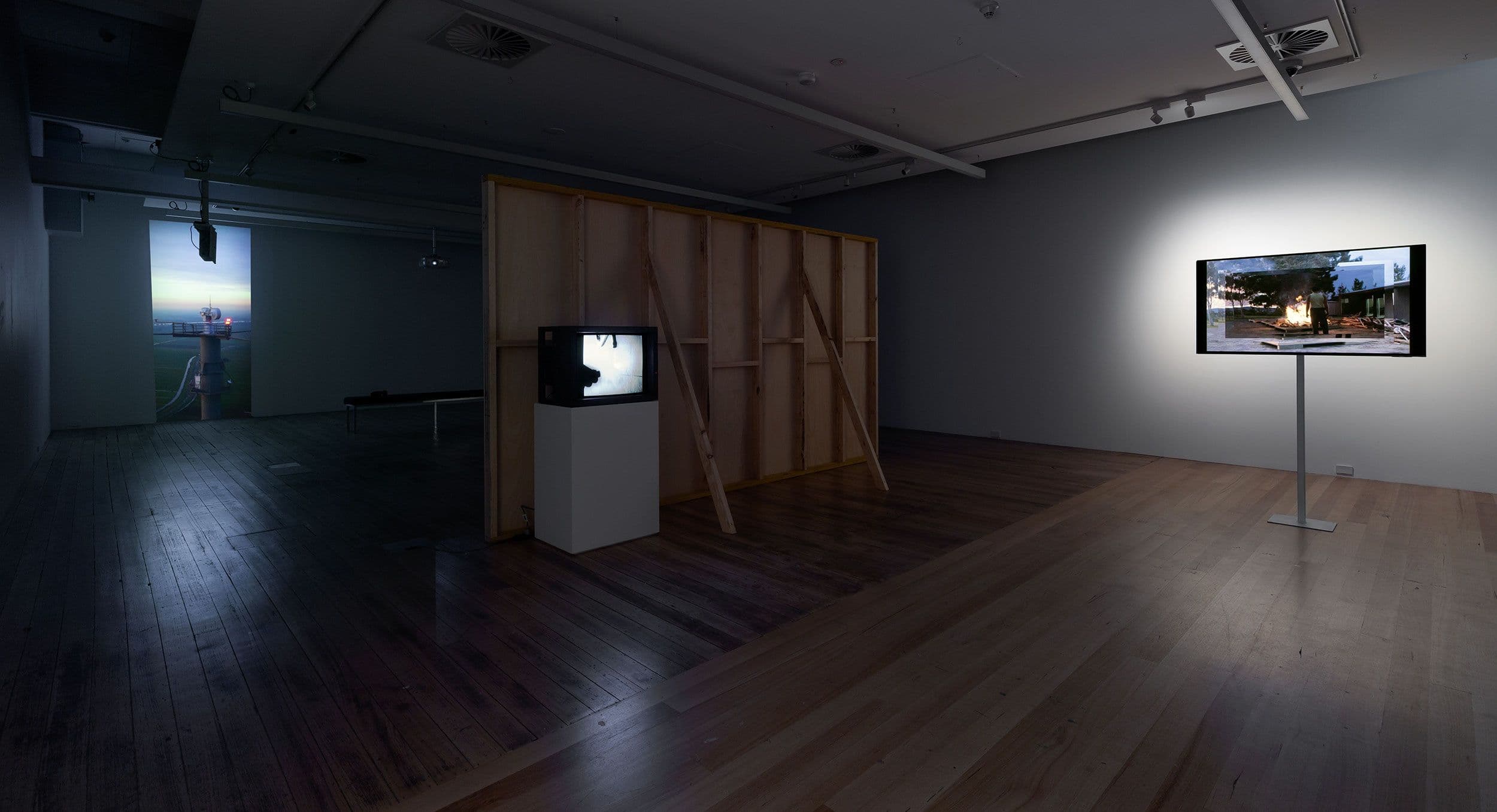
Impermanent Shelter, installation view, MADA Gallery, Monash University, Naarm/Melbourne, 2022 photo: Christian Capurro.
In Klein’s Essai de toit d’air (Air roof test) (1961) he demonstrates his patented use of pneumatic air to displace water. In the later sketches by Parent, Klein’s vision for a “new Eden” of immaterial structures is vividly illustrated. Through the use of his air roof across large geographical distances and within smaller dwellings, Klein dreamt of “absolute control of the Climate”, air conditioning the surface of the globe to create ideal spaces for living, as a means “to find nature and live once again on the surface of the whole of the earth without needing a roof or a wall. To live in nature with a great and permanent comfort.” Klein’s dream implemented–at least theoretically–his fascination with The Void and the immaterial into everyday life, making of the air a ‘material’ that generated shelter but no visual presence. Echoes of Buckminster Fuller’s geodesic dome, a more permanent though still ephemerally-inclined structure, abounds. Yet instead of Fuller’s soap bubble-like dome, Klein’s vision utilised his air roof to protect against external conditions and walls of fire to generate heat. Though Klein’s project was not realised, it precedes architecture’s ongoing fascination with the idea of an immaterial building.
Impermanent Shelter twists this preoccupation to consider an alternate intersection of the atmosphere and structure – utilising this as a way to critically engage with permanent settlement in multiple senses in a present era of climate crisis, a period which appears to increasingly prioritise states of impermanence. The contemporary works presented here tease out these notions of present day forms of “air architecture” in divergent, critical and reflective ways.
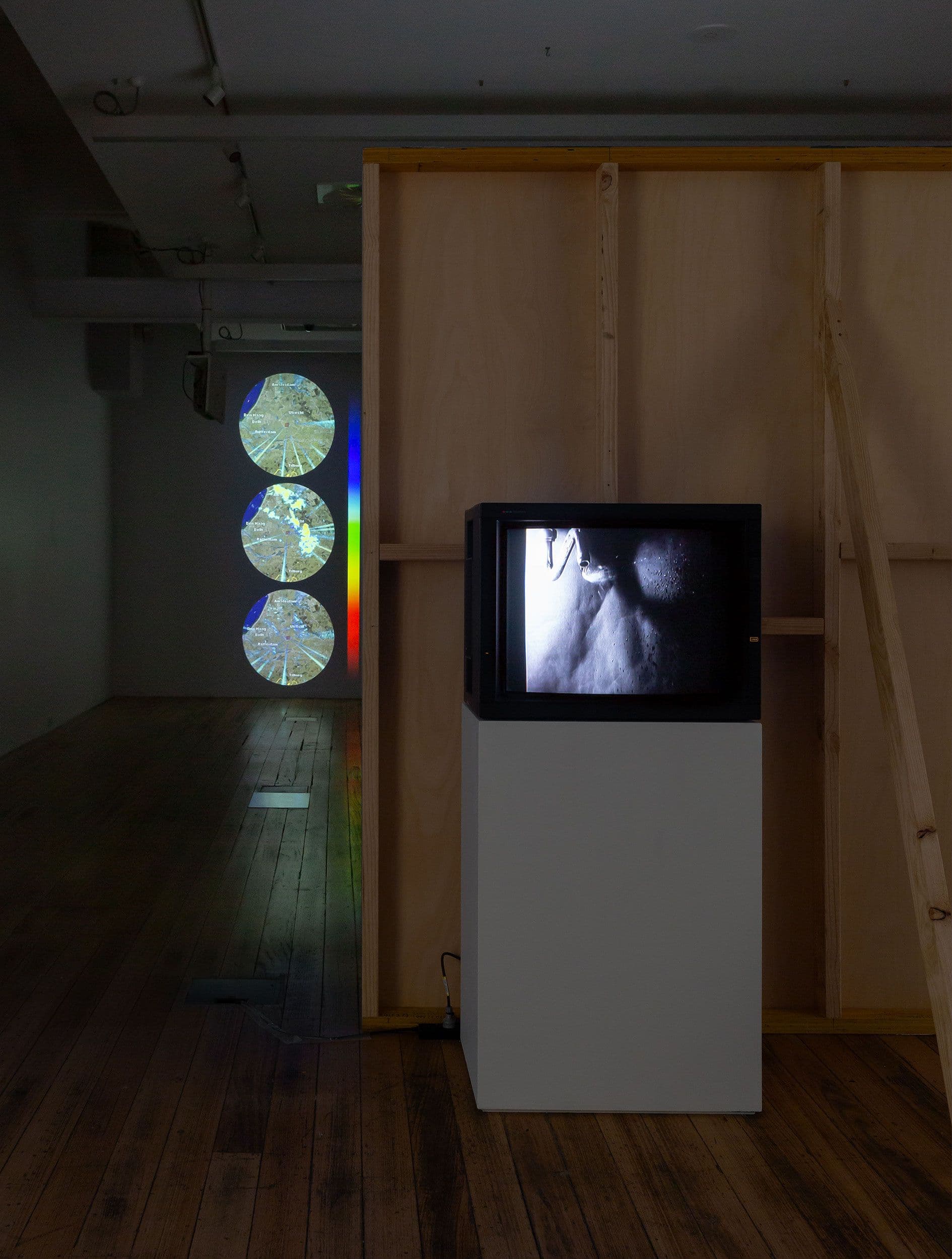
[Foreground] Yves Klein, Essai de toit d’air (Air roof test), 1961, film transferred to digital video, silent, 2:16 mins, looped, courtesy of the Estate of Yves Klein, © Succession Yves Klein c/o ADAGP, Paris; [Background] Susan Schuppli, Atmospheric Feedback Loops, 2017, 35mm vertical film transferred to HD video, sound, 17:50 min, looped, Courtesy of the artist. Photo: Christian Capurro.
In Ben Rivers’ Urth (2016) the viewer is afforded a fragmented tour of the scientific facility Biosphere 2 via the lens of the British artist’s Bolex 16mm camera. Set within the foothills of the Santa Catalina Mountains in Arizona, the facility is a series of sealed geodesic domes and pyramids that from 1991 housed a team of eight scientists for a two year period. Designed as a self-sufficient, oxygen-generating microcosm of Biosphere 1 (Earth), across its two year test cycle Biosphere 2 descended into chaos due to a mix of system failures, the unexpected growth of oxygen-sucking bacteria, and tense interpersonal dynamics. Rivers’ film eschews revelling in the failure of the project’s lofty aims. Instead, it ambivalently observes the project’s latent utopic resonance – evoked in the external shots of the complex, with the camera dwelling on the structural forms’ as if to emphasise its strange presence; a kind of anachronism of the future. Interior shots explore the facility’s multiple biomes in close detail, with signs of its ongoing occupation and maintenance. A lone woman’s voice–framed speculatively as the last remaining crew member of an alternate version of the project–narrates, repeatedly pining for a wind to rustle the stilled plants and in a darker moment, ponders how her ashes might be scattered if there is no breeze to carry them. The structure and its residual aspirations recall the controlled climatized spaces of Klein’s original proposal and like it, how these dreams inevitably fall victim to the meeting of utopian thinking with human fallibility.
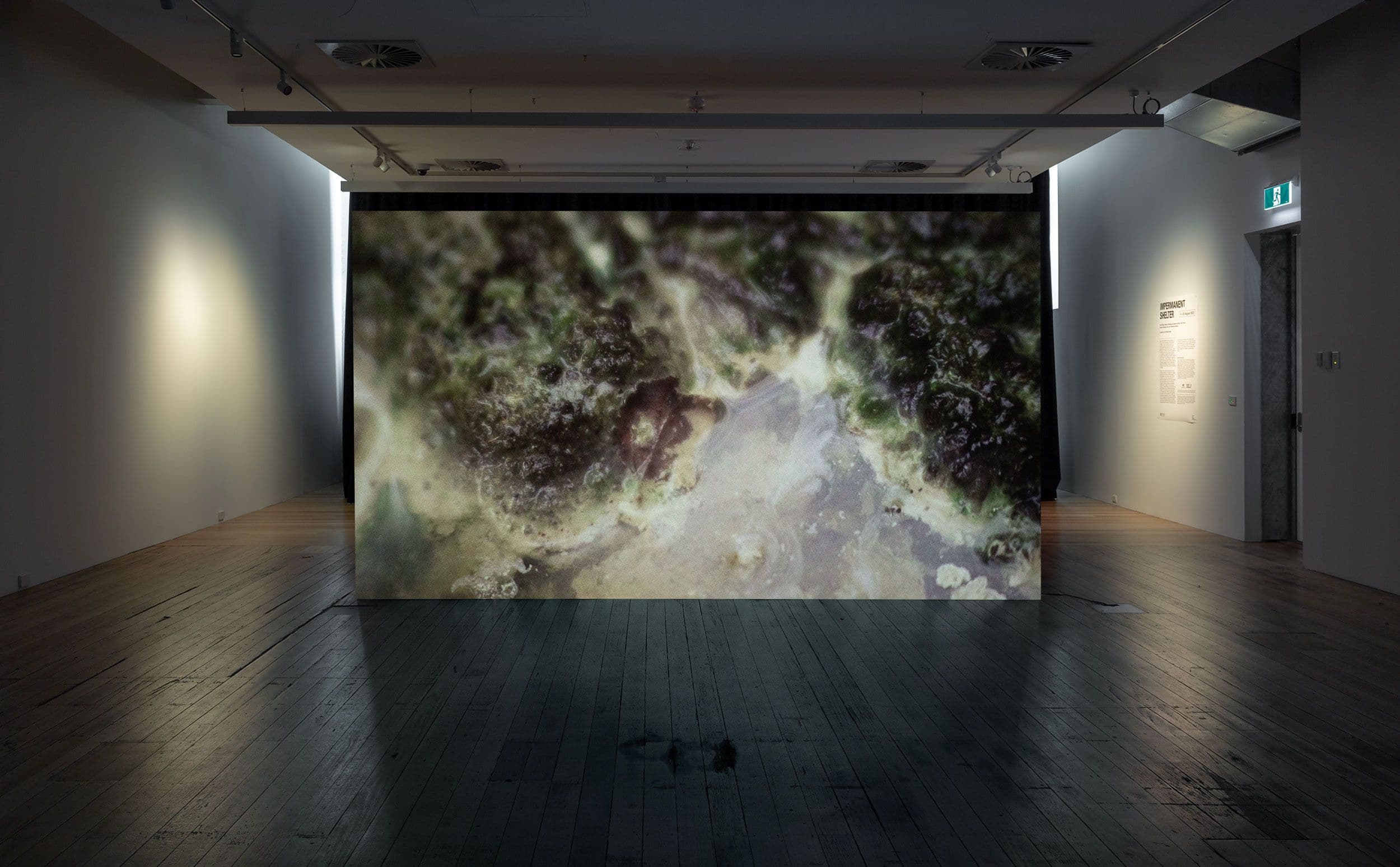
Sasha Litvintseva & Graeme Arnfield, Asbestos, 2016, HD video, sound, 19:28 min. Courtesy of the artists. Photo: Christian Capurro.
The SF bent of Rivers’ work continues in Sasha Litvintseva and Graeme Arnfield’s Asbestos (2016). At times, the POV occupies that of a hazmat-sealed worker within a building site. In others, it captures scenes from around the town of Val-des-Sources, Quebec; until 2020 known by its original name, Asbestos. A sign welcomes viewers to its decidedly conventional suburban streets. A shot from above shows the remnants of the open-cut Jeffrey Mine, once the largest asbestos mine in the world. Thin roads at its edge course toward a body of water that fills the floor of this vast, man-made wound. The town and mine sit as colonial impositions on the lands of the Abenaki Nation, now cut and gouged by extractivist-led violence. At peak levels of production, it was said local children could write their names in the thick asbestos dust that settled around town. The titular material’s name has etymological roots to the Greek word, translating to unquenchable or inextinguishable, reflecting its once highly-desirable fire-retardant capability that saw its utilisation in insulation, roofing, protective clothing, and more. Found footage relating to asbestos situates the product’s global ubiquity through advertisements and the dawning recognition of its toxicity. Here, an air architecture is read as the material structure itself entering the atmosphere as an inhalable, carcinogenic particulate matter.
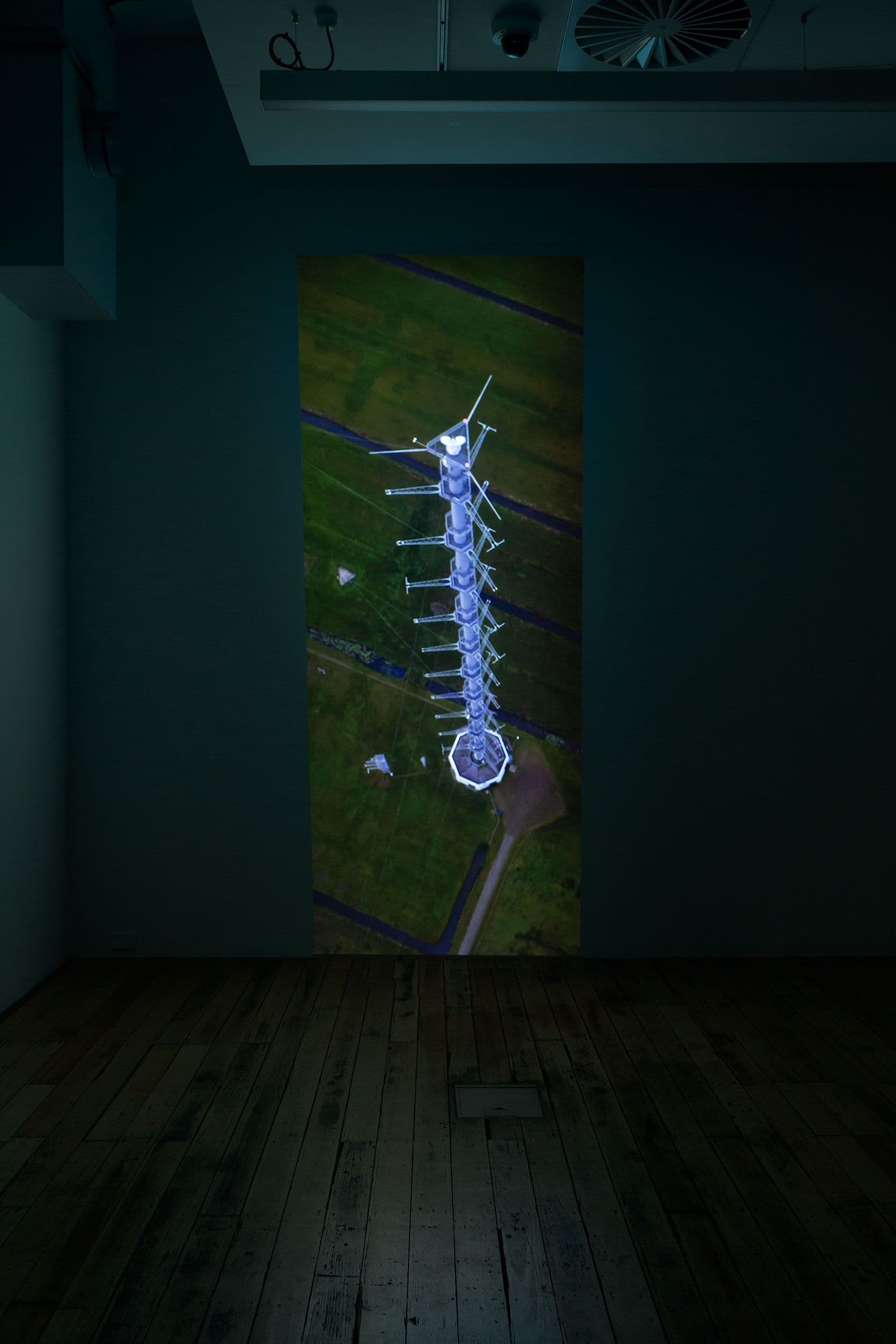
Susan Schuppli, Atmospheric Feedback Loops, 2017, 35mm vertical film transferred to HD video, sound, 17:50 min, looped. Courtesy of the artist. Photo: Christian Capurro.
The structure depicted in Susan Schuppli’s Atmospheric Feedback Loops (2017) is no shelter, but its scientific mission offers the promise of comprehending threats against the future certainty of Earth as a shelter for humanity. The towering “high measurement mast”, adjoining structures and devices that feature in the vertical film constitute the Cabauw Experimental Site for Atmospheric Research, established in 1970 in the Dutch rural countryside an hour outside of Amsterdam. At Cabauw, scientists study the interactions between atmospheric phenomena and terrestrial events, separating the evidence of climate change from the inherent cyclical variations of the planet. Here, climate science and visual culture intersect in a generative way. In the 17th century this region played host to artists such as Jacob van Ruisdael (1628/9–1682), renowned for his landscapes’ emulation of the particular quality of light, Hollands licht, that the country was once known for. Joseph Beuys, as Schuppli’s video’s narrator describes, theorised that the Dutch land reclamation movements of the mid 20th century had impacted this light’s existence dramatically. Human interference displaced it and “the air was said to have lost its refractive shimmer”. By comparing Cabauw’s readings with van Ruisdael’s landscapes, art is utilised as Schuppli has discussed separately as a form of “proxy data” allowing new insights into the impact of global warming and hinting at the possibility of climate justice on behalf of the Planet.

Joel Sherwood Spring, need more, 2022, HD video, sound, 9:34 mins, looped. Courtesy of the artist.
Echoing Schuppli’s interest in material witness and the pursuit of evidence for justice, Joel Sherwood Spring’s need more (2022) is a new work that continues the Wiradjuri anti-disciplinary practitioner’s recent engagement with the settler colonial built environment, the crucial centering of cultural fire of environmental rehabilitation, and the ecological aftermath of the Black Summer bushfires of 2019–20. This video functions as a concurrent work to Sherwood Spring’s untitled (winhangarra) 2022 project for the National Gallery of Australia. It also reflects the artist’s ongoing interest in video-based ‘essays’ that utilise screen-recording software to capture a choreographed succession of found images and footage that interrogate neocolonial structures of violence. Neocolonialism’s insistence in this country on fire-resisting structures instead of fire-accepting ones as Kevin O’Brien has argued elsewhere reflects one example of this persistent illogic in the face of the land’s natural bushfire cycles and climate change-fuelled megafires. Instead, O’Brien’s propositional response to this is a different interpretation of an impermanent shelter: a future architecture that privileges camping and transience over bricks and mortar. need more’s centring in the space functions as a vital and critical counterpoint to the utopian aspirations that course through Klein’s idealistic practice, Biosphere 2’s techno-futurist mission, and the dispersed, aerial asbestosis violence caused by extractivism. An imperial methodology of man over nature clearly persists. But as the sulphur-crested cockatoo seen briefly in Sherwood Spring’s work evidences as it rips rows of bird spikes from an apartment block’s windowsill and throws them to street level, even seemingly permanent structures can be undone.
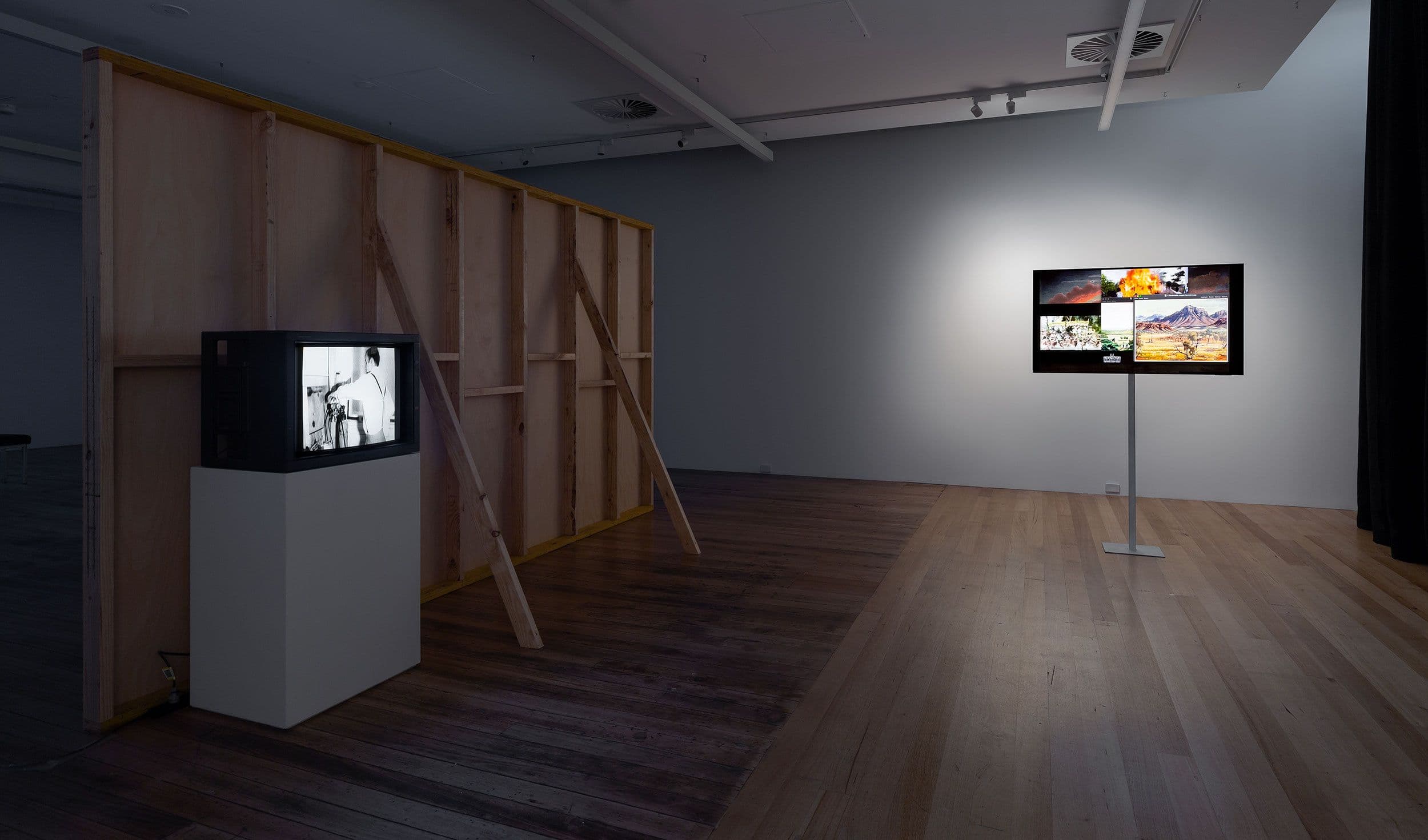
Impermanent Shelter, installation view, MADA Gallery, Monash University, Naarm/Melbourne, 2022 photo: Christian Capurro.
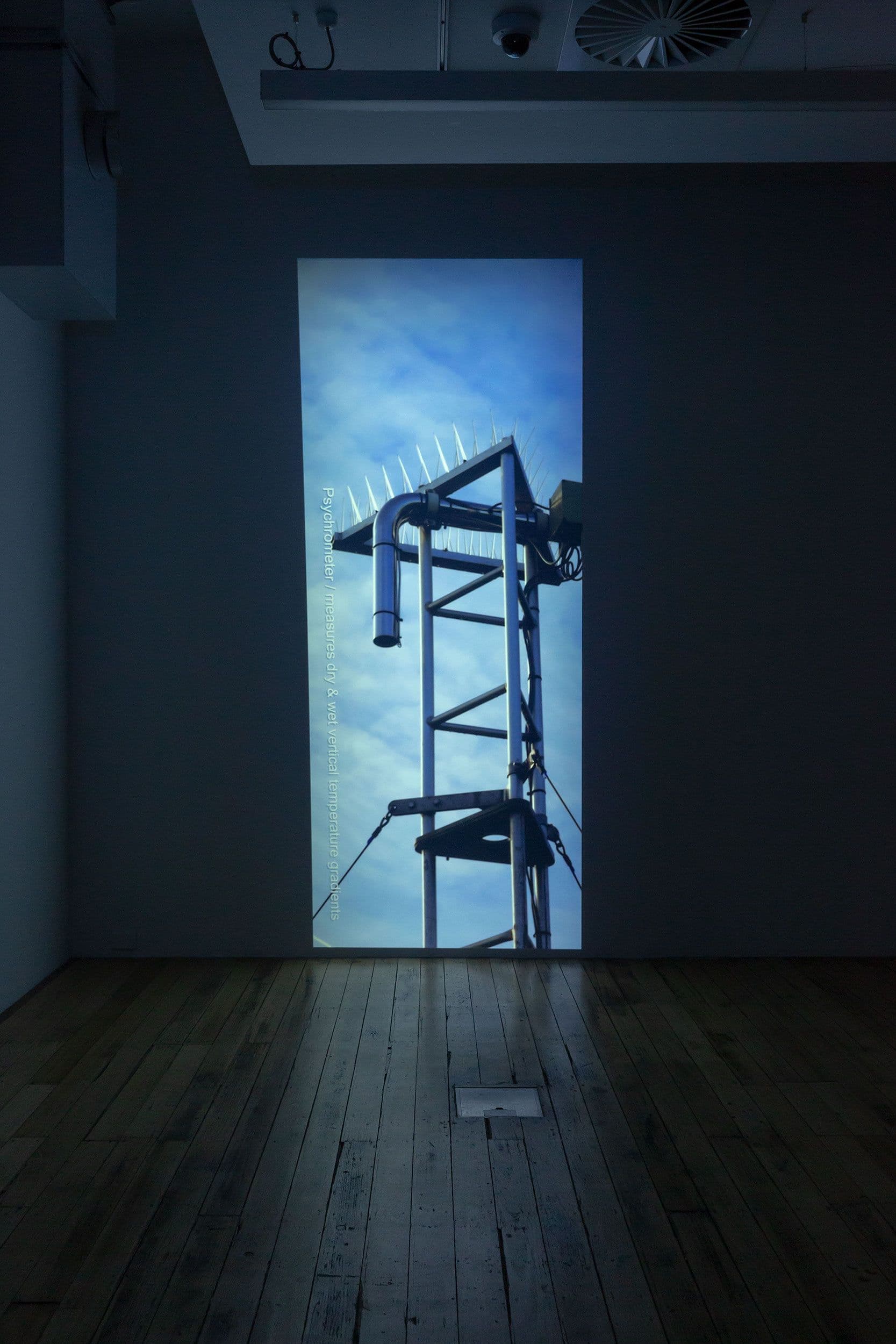
Susan Schuppli
Atmospheric Feedback Loops, 2017
35mm vertical film transferred to HD video, sound, 17:50 min, looped
Courtesy of the artist.
Notes
Examples include Robert Barry’s Inert Gas Series/Helium, Neon, Argon, Krypton, Xenon/From a Measured Volume to Indefinite Expansion (1969), Michael Asher’s air curtain exhibited in Anti-Illusion: Procedures/Materials at the Whitney Museum in 1969, and Art & Language’s Air-conditioning Show / Air Show / Frameworks (1966–67). Prior to Klein, an earlier example ofthis interest is reflected in Marcel Duchamp’s 50 cc of Paris Air (1919).
Yves Klein, Rocket Pneumatique (Pneumatic Rocket), 1962, painted and chromed metal, painted rubber, 89 x 75 x 69 cm; Klein’s rocket was “made to travel through space, it would convey no information, carry no travellers and have no destination. Its sole vocation was to leave Earth and to return to the cosmic void, and not to return,” see Christelle Lecoeur, “Yves Klein Claude Parent – The Memorial, An Architecture Project”, Editions Dilecta, Paris, 2013.
Klein designed two monochromes for the site, large murals in his distinctive International Klein Blue.
Yves Klein, Architecture de l’air, 1961, dry blue pigment synthetic resin and charcoal on paper on fabric, 261.6 x 213.3 cm, Collection: Tokyo Metropolitan Museum, Tokyo, Japan.
Yves Klein, “Air Architecture and Air Conditioning of Space,” in Yves Klein: Air Architecture, eds. Peter Noever and François Perrin (Los Angeles: MAK Center for Art and Architecture, 2004), 97.
More recent examples would include Diller Scofidio’s Blur Building, 2002.
My gratitude to Ruth Höflich for her conversation on this work and sharing this phrase with me.
Marie Fazio, “Asbestos, a Canadian Mining Town, Votes to Detoxify Its Name,” The New York Times, 21 October 2020,
https://www.nytimes.com/2020/10/21/world/americas/asbestos-quebec-canadian-town.html.
Within so-called Australia in 2007 asbestos producer James Hardie, a then Chicago-based multinational, was the centre of a legal case for malpractice which they were ultimately found negligent and required to establish a compensation fund for victims.Asbestos continues to be the cause of around 4000 deaths per year nationally, see Matt Peacock, “James Hardie accused of
using ‘same old tricks’ to avoid asbestos compensation,” ABC News, 5 February 2018, https://www.abc.net.au/news/2018-02-05/james-hardie-up-to-same-old-tricks-on-asbestos-compensation/9391708.
Susan Schuppli, Material Witness (Cambridge, MA: MIT Press, 2020).
Kevin O’Brien in O’Brien and Rachel O’Reilly, “Discussion: Fire. Country. City. Architecture.,” in On Fire: Climate & Crisis, ed. Tim Riley Walsh (Meanjin/Brisbane: Institute of Modern Art, 2021), 96–103.
Impermanent Shelter
Curated by Tim Riley Walsh
Artists
- Yves Klein,
- Sasha Litvintseva,
- Graeme Arnfield,
- Ben Rivers,
- Susan Schuppli,
- and Joel Spring Sherwood
4 – 20 August 2022
MADA Gallery
Ground Floor, Building D
Monash University
900 Dandenong Road
Caulfield East VIC 3145
Australia